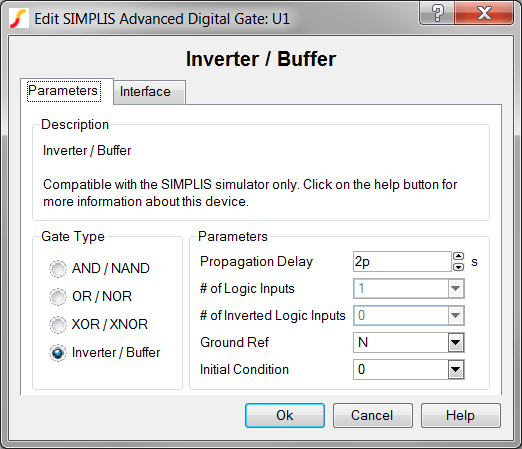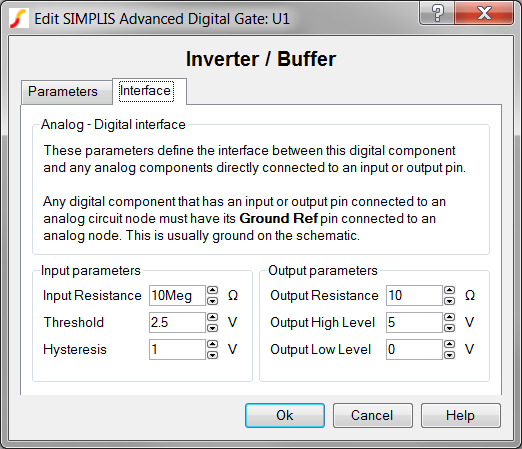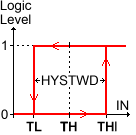Buffer
The Inverter/Buffer models a generic inverter and buffer. Perfectly complementary outputs are provided with both outputs changing state after the Propagation Delay.
In this topic:
| Model Name: | Inverter/Buffer | |||
| Simulator: |  |
This device is compatible with the SIMPLIS simulator. | ||
| Parts Selector Menu Location: | ||||
| Symbol Library: | None - the symbol is automatically generated when placed or edited. | |||
| Model Library: | SIMPLIS_DIGI1.LB | |||
| Subcircuit Names: |
|
|||
| Symbol: |
|
|||
| Multiple Selections: | Only one device at a time can be edited. | |||
Editing the Inverter/Buffer
To configure the Inverter/Buffer, follow these steps:
- Double click the symbol on the schematic to open the editing dialog to the Parameters tab.
- Make the appropriate changes to the fields described in the table below the image.

| Label | Parameter Description |
| Propagation Delay | Delay from when any input pin changes state until the outputs change state |
| Ground Ref | Determines whether or not a device has a ground reference pin. Any digital component that has an input or output pin connected to an analog circuit node must have its Ground Ref pin connected to an analog node. This is usually the ground on the schematic. |
| Initial Condition | Initial condition of the Inverter/Buffer output at time=0 |
To define the parameters for the interface between this digital component and each analog component connected directly to an input or output pin, follow these steps:
- From the Edit Inverter/Buffer dialog box, click on the Interface tab.
- Make the appropriate changes to the fields described in the table below the image.

| Label | Parameter Description | |||||||
| Input Resistance | Input resistance of each Inverter/Buffer input pin | |||||||
| Hysteresis, Threshold |  |
Hysteresis and
Threshold of the inputs. The hysteretic-window width, HYSTWD
is centered around Threshold (TH) voltage. To
determine the actual threshold ( TL , THI ),
substitute Threshold (TH) and Hysteresis
(HYSTWD) in each of the following formulas:
|
||||||
| Output Resistance | Output resistance of each Inverter/Buffer output pin | |||||||
| Output High Voltage | Output high voltage for each Inverter/Buffer output pin | |||||||
| Output Low Voltage | Output low voltage for each Inverter/Buffer output pin | |||||||
Truth Table
| Input | Outputs | |
| Buffer | Inverter | |
| 0 | 0 | 1 |
| 1 | 1 | 0 |
Examples
The test circuit used to generate the waveform examples in the next section can be downloaded here: simplis_059_inverter_example.sxsch.
Waveforms
The waveforms below were taken from a simple inverter test circuit where the input is connected to a digital pulse source.

Subcircuit Parameters
The subcircuit parameters, parameter names, data types, ranges, units, and descriptions
are in the following table. The parameter names can be used to directly generate netlist
entries for the device. For example, the netlist entry for an Inverter/Buffer with active-high inputs and without ground reference would
be as follows:
X$U1 3 4 2 SIMPLIS_DIGI1_BUF_N vars: IC=0 RIN=10Meg ROUT=10 HYSTWD=1 VOL=0 VOH=5 DELAY=2p TH=2.5
| Parameter Name | Label | Data Type | Range | Units | Parameter Description | |||||||
| DELAY | Propagation Delay | Number | 1f to 1024 | s | Delay from when any input pin changes state until the outputs change state | |||||||
| GNDREF | Ground Ref | String |
|
none | Determines whether or not a device has a ground reference pin. Any digital component that has an input or output pin connected to an analog circuit node must have its Ground Ref pin connected to an analog node. This is usually the ground on the schematic. | |||||||
| HYSTWD, TH |
Hysteresis, Threshold |
Number | min: 1f | V |  |
Hysteresis and Threshold of
the inputs. The hysteretic-window width, HYSTWD is centered
around Threshold (TH) voltage. To determine the actual
threshold ( TL , THI ), substitute Threshold
(TH) and Hysteresis (HYSTWD) in each of the
following formulas:
|
||||||
| IC | Initial Condition | Number |
|
none | Initial condition of the Inverter/Buffer output at time=0 | |||||||
| RIN | Input Resistance | Number | min: 100 | Ω | Input resistance of each Inverter/Buffer input pin | |||||||
| ROUT | Output Resistance | Number | min: 1m | Ω | Output resistance of each Inverter/Buffer output pin | |||||||
| VOH | Output High Voltage | Number | any | V | Output high voltage for each Inverter/Buffer output pin | |||||||
| VOL | Output Low Voltage | Number | any | V | Output low voltage for each Inverter/Buffer output pin | |||||||
